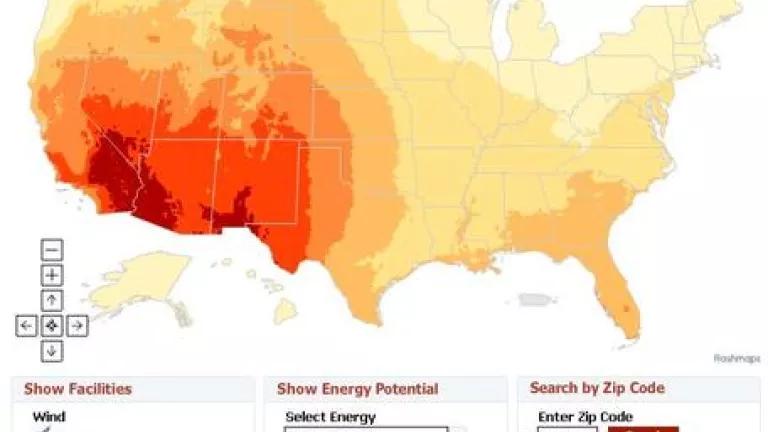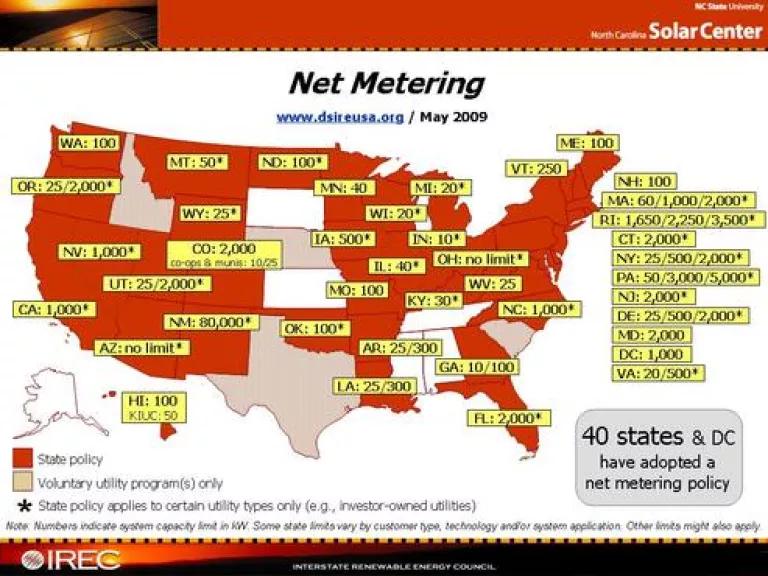
In the world of energy and climate policy we often talk about subjects on a gargantuan scale: big power plants, trillions of Btu's, global emissions, billions of dollars, etc. Earlier this year I blogged on the topic of distributed renewable energy - the 'little guy' - taking cues from the ever-influential energy visionary, Amory Lovins. Despite the fact that we often cite big numbers for big problems (e.g. global warming) , we shouldn't overlook the importance that the 'little guy' can play in making a big difference to meet our energy, security and climate challenges for this new century.
Clearly displayed on the Renewable Energy for America website map that we recently launched (screenshot below), the potential is immense throughout the U.S. for distributed renewable energy such as solar photovoltaic and concentrating solar. Stay tuned because in a few months as we will display on the map the larger scale planned and existing solar projects.
There's plenty of opportunity for the 'little guy' especially after you take a look at NRDC's equally important Google Earth map tool that highlights sensitive and protected wild lands to guide new clean energy planners and developers. Ample distributed renewable energy development opportunity exists in already-developed places, which, not-so-coincidentally, happen to be the places with the highest concentration of energy use.
Now that you see there is plenty of potential out there, how do we help the 'little guy' produce big energy results?
To frame this brief discussion, I first offer you a hypothetical question in the world of fast food ... What if each state required a differing set of ingredients in differing proportions to make French fries for fast food sales? Would French fries be as main stream as they are today if such a myriad of French fry laws existed? Perhaps an alternative potato-based complement to the 'ole burger would have emerged more popular - like chips or mashed potatoes??? But I digress; my point here is to serve up an illustration as I next move to describe in a bit more detail, the big problem facing distributed renewable energy development.
Cleaning Up the Mess Out There
Well-intentioned states (40 states + D.C. in all) looking to develop distributed renewable energy industries in order to grow green jobs at home and reduce dependency on dirty, price-volatile and imported fossil energy supplies implemented payment structure policies between utilities and distributed generation (DG) renewable energy system owners known as net metering. Net metering is a billing structure arrangement that essentially requires utilities pay back renewable energy system owners at a fair retail price when these energy systems are able to put energy back onto the grid. Renewable energy market studies show that net metering (see Figure 1 below) along with other important policies that we strongly support such as the federal investment tax credit, renewable portfolio standards, and electric utility revenue decoupling have spurred new growth in distributed renewables in states.

Figure 1: Number of Annual Grid-Connected Photovoltaic Installations (1998-2007). Source: IREC 2008.
But despite this rapid growth, the companies that specialize in distributed renewables project development (e.g. designers and installers) are hitting a ceiling, due in part to the myriad different forms of net metering policy structures around the country. Whether its different installation size limits, payment schemes, or hard-to-predict overall program size or cost limitations (see Figure 2) we think there's a workable solution that can be easily implemented.

Figure 2: Number of Annual Grid-Connected Photovoltaic Installations (1998-2007). Source: IREC 2009.
The Solution
Get all states to adopt uniform model net metering rules and accompanying interconnection standards (interconnection refers to the required steps that the renewable energy system installer and electric utility grid company need to take to ensure a safe and reliable connection to the electric grid).
Implementing the Solution
Sponsored by Senators Robert Mendendez (D-NJ) and Bernie Sanders (I-VT), a new bill arrived on the scene on Capitol Hill on May 6 with a sub-committee hearing scheduled today in the Senate Energy and Natural Resources Committee. The purpose of the hearing is to:
... receive testimony on net metering, interconnection standards, and other policies that promote the deployment of distributed generation to improve grid reliability, increase clean energy deployment, enable consumer choice, and diversify our nation's energy supply.
While there are necessary tweaks to the bill that we feel need to happen, it's an important and good starting point to making the 'big' fix necessary for the 'little guy' to participate. Wouldn't it be something if clean distributed renewable energy (whether in the form of solar PV, small wind turbines, etc.) were as common as the phrase, "Would you like French fries with that"? I'm hungry.